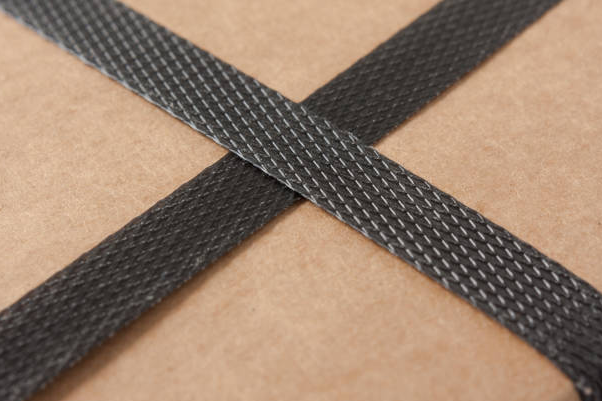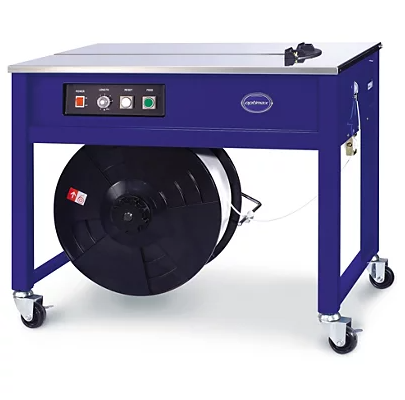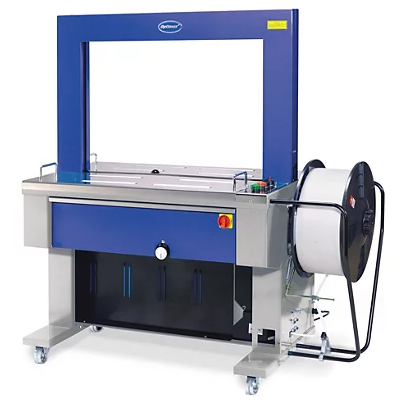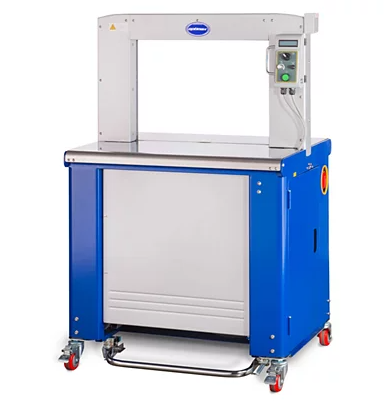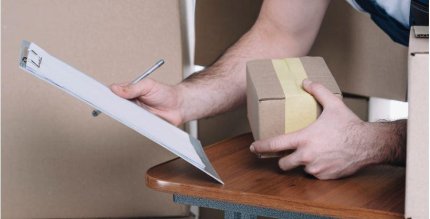Strapping up a package is a big job and one that can be automated pretty effectively. Using a hand strapping machine is a great way to wrap uneven items or pallets that just need that extra touch but if you need to do a lot of items that are all the same size? Then it’s time to look at some strapping machines.
What is a Strapping Machine?
A strapping machine is a packaging tool used to secure and bundle products or materials with a strap, typically made of plastic. The machine wraps the strap around the items, tightens it to ensure a secure hold, and seals the ends, either through heat, friction, or a buckle.
This process helps stabilize loads for storage or transport, making it a common choice for securing boxes, pallets and other large shipments in warehouses and shipping facilities. Strapping machines increase efficiency and ensure consistent, tight packaging compared to manual strapping.
You can get smaller options like a hand strapping machine or a strapping trolley but for some real automation you need to look at one of the bigger models that has a more complete and higher spec. If you’re looking to purchase one, there are a number of elements you need to consider and each model will be different – here are some of the key metrics you may need to look at.
What elements of a strapping machine do I need to know?
There are quite a few different ways to measure the performance of a strapping machine, here are some of the most important.
- Tensioning Force – the tensioning force of strapping is the amount of pressure that can be applied by the strapping. Obviously heavier loads will require a greater force of tension measured in kg in order to remain stable.
- Cycles per minute – this is the number of times the machine can cycle through a strapping procedure, a rough gauge of the maximum speed the machine can operate at – it will of course depend on the operator as well as what manner of straps are being applied.
- Table Height – the height of the table will also affect how you package your goods, and having a table that is adjustable gives you a wider range of options that you can work with.
- Net Weight – the total weight of the strapping machine which is important when considering how mobile you need it to be as well as where you intend to place the machine.
- Dimensions – similar to net weight, being confident of the size of your strapping machine will help you to know where it will fit within your operation.
- Arch – on a strapping machine, the arch is an essential element that helps to automate the strapping procedure with greater speed. It’s essential for automatic strapping machines of a certain level.
- Core Diameter – the core diameter will decide what types of strapping you can fit to your machine – a core diameter of say 200mm will mean you have to use rolls that fit that size for the machine to operate.
- Compatible strapping – this one will be down to the machine itself but making sure the machine is compatible with the strapping you wish to use is a vital step in your purchasing journey.
What types of Strapping Machines are there?
Broadly speaking, if we’re looking at large tabular strapping machines you will end up with three options. Semi-automatic, automatic and potentially high speed. We sell one of each so we can give you an assessment of how each one works for you to assess.
Semi-automatic strapping machines
Our semi-automatic strapping machine is definitely the lightest of its siblings at just 85 kg. It’s also the only one that lacks an arch. It does have the widest range of adjustable heights however and the widest range of options when it comes to which strapping to use. Both the strap width and core diameter can be varied while still providing a respectable range of tensioning force. The main feature of this model is how varied it can be both in what it straps and what strapping it uses.
Automatic strapping machine
Moving on to our automatic strapping machine, you’ll notice the speed immediately as it’s capable of up to 27 cycles per minute. It also has a wide range of tensioning force from 10kg all the way up to 70kg and can work with a similar range of strapping as the semi automatic model (although strap width is set). However this does come at a cost, the machine itself is significantly heavier than the semi-automatic model at 280 kg. It’s also got greater dimensions in order to accommodate the arch as well as not having an adjustable table height. The wider range of tensioning force makes this model perfect for packaging a wider array of products
High Performance Automatic Strapping machine
The undisputed speed king of our strapping machines, the high-performance automatic strapping machine can push out an incredible 65 cycles per minute! Easy to operate, as are all the models, the sheer speed of strapping makes this an efficiency must have for many workplaces. However, there is still a cost. While its weight is lower than the automatic and it still has an adjustable table height, it also has lower tensioning force with 1-25 kg being the range.
How do they compare?
Well, it’s difficult to pick a favourite as each model has its own pros and cons. To help with your decision making, we’ve put together a table listing the core attributes that each model has.
| Semi-automatic | Automatic | High Speed | |
| Tensioning Force | 15-45 kg | 10-70 kg | 1 – 25kg |
| Maximum cycles per minute | 24 | 27 | 65 |
| Power Supply | 230 v | 230 v | 230 v |
| Table Height | 730-930 (adjustable) | 810 mm | 820-920 mm (adjustable) |
| Net Weight | 85 kg | 280 kg | 166 kg |
| Dimensions | W 902mm H 930mm D 586mm | W 1430mm H 1540mm D 620mm | W 840 mm H 1305 mm D 650 mm |
| Arch | N/A | W 850mm H 600mm | W 650 mm H 500 mm |
| Strap Width | 6-15.5mm | 12 mm | 12 mm |
| Core Diameter | 200 and 280mm | 200 and 280 mm | 200 mm |
| PRICE | £965 | £3,236 | £6,919 |
Whichever machine you choose, make sure you also get enough strapping to get all your packages strapped up tight! Whether it’s polyester, paper all the way up to steel, we have a wide range of products to make sure you have the right tool for your package.







